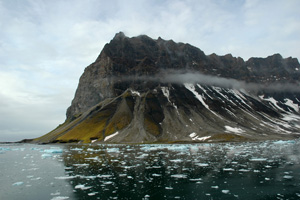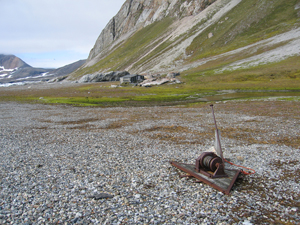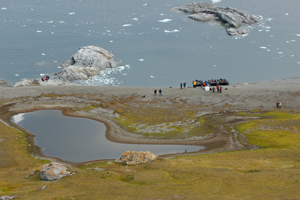Gnålodden [77° 01' N 15° 52' E]By Øystein Overrein (ed.), Jørn Henriksen, Bjørn Fossli Johansen, Kristin PrestvoldThe name Gnålodden is derived from the adjacent bird cliff Gnålberget (759 m.a.s.l.), which is home to thousands of nesting black-legged kittiwakes and Brünnich’s guillemots. These birds are responsible for the constant noise during the nesting season that has given the place its name (“gnål” means “nagging” in Norwegian). Amongst the trappers the site was called Fuglefjell (the bird cliff). The satellite station located here was difficult to access from land, due to the dangers involved in crossing glaciers and steep slopes, ending in cliffs. But a landing in Gnålodden offers an exciting landscape, proximity to birdlife and a historic walk between cultural remains. The place also offers good growth conditions for plantlife and many alpine plant species are easily accessible. Take care:




Below the fantastic bird cliff Gnålberget, there is an old trappers’ cabin. It was used for many years by Anders Sæterdal and his wife Wanny Woldstad, who is famous for being the first female trapper in Svalbard. In the 1930s the cabin at Gnålodden served as a satellite station, and their main station was a cabin in Hyttevika by the entrance of the Hornsund fjord. The cabin was later rebuilt by other trappers. Today scientists from the Polish Research Station in Isbjørnhamna often use the cabin. The cabin is maintained by the Governor of Svalbard and is in good repair. Forming a spectacular landscape, rounded limestone cliffs dominate the beach at Gnålodden. Before landing it is advisable to do a recognisance, first with a small boat, to get a good overview from the sea. There are many blind spots at Gnålodden where polar bears can hide. When the area is cleared and people are ashore, post guards at selected viewpoints to keep watch for incoming polar bears. At the eastern side there is a hill from where you can get a good view of the beach towards Løyndodden, and around the cabin there are several rocky crags that offer good lookouts. The risk of meeting polar bears is particularly high just after the Brünnich’s guillemot chicks have jumped off the ledges. All wildlife at Gnålodden profits from the bird cliff. At the base of the mountain, glaucous gulls nest – often on top of limestone rocks. Great skuas also nest in the area and barnacle geese often feed in the steep, grassy slope below the vertical cliff. Fox dens can be found in the area and if you are lucky you may glimpse an Arctic fox that is busy caching food and feeding up for the winter. At low tide you can walk along the beach west of the cabin. About 150 m from the cabin there is a stream of water seeping out from cracks in the ground, forming a little stream that runs the few metres out to the sea. This is a thermal spring that reaches the surface through cracks in the limestone. The water is heated by the higher temperature of the deeper ground, where it is circulated in karst holes. In the tidal zone zooplankton get trapped in the small tidal ponds as the tide goes out. Eastwards along the beach from the landing site there is another, much shallower cove that often traps beautiful pieces of ice from the calving glacier. There is an old Russian site at the eastern side of the cove, and at the hill just south of the site there is a grave from the whaling era. So, in this small area there are cultural remains from three epochs in the Svalbard history – Norwegian overwintering hunting, Russian Pomor and whaling. Vulnerable elementsIf you are at Gnålodden when the Brünnich’s guillemot chicks jump (leave the ledges), in the beginning of August, do not land. This is because groups of tourists may reduce the chances for survival both for the chicks and other predatory species that feed on the chicks, such as glaucous gull, great skua and Arctic fox. Landing sitesThe best landing site is the bay east of the cabin. You can find an alternative landing site west of the cabin, but be aware of the sunken rocks that may make landings difficult, especially at low tide. Recommended trailsYou can walk along the shore both in easterly and westerly directions from the cabin, but westerly only at low tide. The thermally heated stream is located 150 meters west of the cabin, and the cultural remains from the Pomors and the whalers are located to the east. There are several good viewpoints on top of rocks and hills in this area. Association of Arctic Expedition Cruise Operators (AECO) offers guidelines for travellers visiting Gnålodden. Updated March 2015 |
The Cruise Handbook is also available in book formHard cover with numerous pictures - 249 pages - NOK 249.00 Norwegian Polar Institute |
 Norsk
Norsk